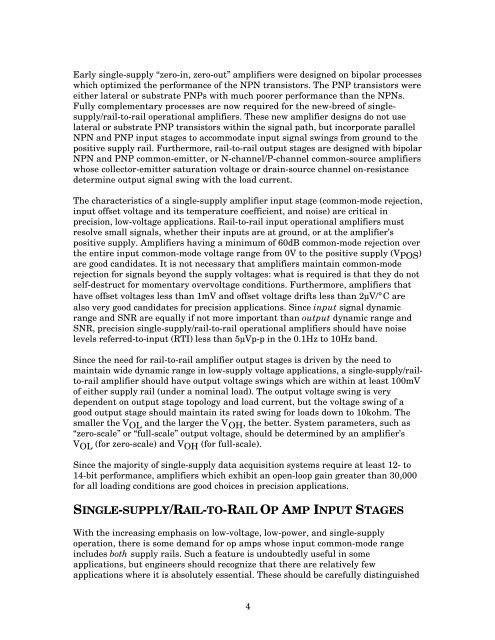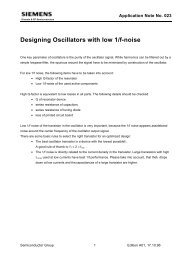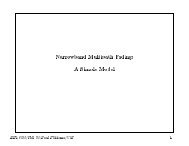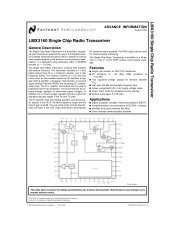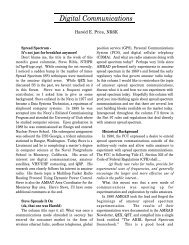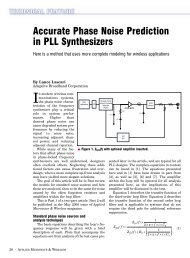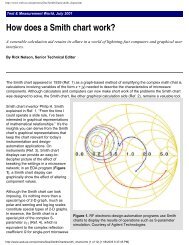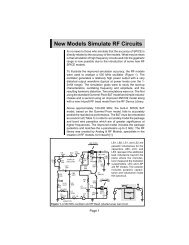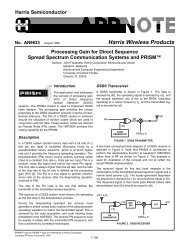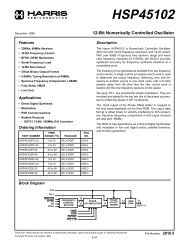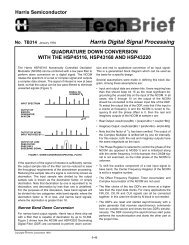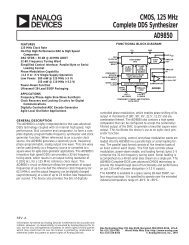SECTION 1 SINGLE-SUPPLY AMPLIFIERS - Analog Devices
SECTION 1 SINGLE-SUPPLY AMPLIFIERS - Analog Devices
SECTION 1 SINGLE-SUPPLY AMPLIFIERS - Analog Devices
- No tags were found...
Create successful ePaper yourself
Turn your PDF publications into a flip-book with our unique Google optimized e-Paper software.
Early single-supply “zero-in, zero-out” amplifiers were designed on bipolar processeswhich optimized the performance of the NPN transistors. The PNP transistors wereeither lateral or substrate PNPs with much poorer performance than the NPNs.Fully complementary processes are now required for the new-breed of singlesupply/rail-to-railoperational amplifiers. These new amplifier designs do not uselateral or substrate PNP transistors within the signal path, but incorporate parallelNPN and PNP input stages to accommodate input signal swings from ground to thepositive supply rail. Furthermore, rail-to-rail output stages are designed with bipolarNPN and PNP common-emitter, or N-channel/P-channel common-source amplifierswhose collector-emitter saturation voltage or drain-source channel on-resistancedetermine output signal swing with the load current.The characteristics of a single-supply amplifier input stage (common-mode rejection,input offset voltage and its temperature coefficient, and noise) are critical inprecision, low-voltage applications. Rail-to-rail input operational amplifiers mustresolve small signals, whether their inputs are at ground, or at the amplifier’spositive supply. Amplifiers having a minimum of 60dB common-mode rejection overthe entire input common-mode voltage range from 0V to the positive supply (V POS )are good candidates. It is not necessary that amplifiers maintain common-moderejection for signals beyond the supply voltages: what is required is that they do notself-destruct for momentary overvoltage conditions. Furthermore, amplifiers thathave offset voltages less than 1mV and offset voltage drifts less than 2µV/°C arealso very good candidates for precision applications. Since input signal dynamicrange and SNR are equally if not more important than output dynamic range andSNR, precision single-supply/rail-to-rail operational amplifiers should have noiselevels referred-to-input (RTI) less than 5µVp-p in the 0.1Hz to 10Hz band.Since the need for rail-to-rail amplifier output stages is driven by the need tomaintain wide dynamic range in low-supply voltage applications, a single-supply/railto-railamplifier should have output voltage swings which are within at least 100mVof either supply rail (under a nominal load). The output voltage swing is verydependent on output stage topology and load current, but the voltage swing of agood output stage should maintain its rated swing for loads down to 10kohm. Thesmaller the V OL and the larger the V OH , the better. System parameters, such as“zero-scale” or “full-scale” output voltage, should be determined by an amplifier’sV OL (for zero-scale) and V OH (for full-scale).Since the majority of single-supply data acquisition systems require at least 12- to14-bit performance, amplifiers which exhibit an open-loop gain greater than 30,000for all loading conditions are good choices in precision applications.<strong>SINGLE</strong>-<strong>SUPPLY</strong>/RAIL-TO-RAIL OP AMP INPUT STAGESWith the increasing emphasis on low-voltage, low-power, and single-supplyoperation, there is some demand for op amps whose input common-mode rangeincludes both supply rails. Such a feature is undoubtedly useful in someapplications, but engineers should recognize that there are relatively fewapplications where it is absolutely essential. These should be carefully distinguished4


